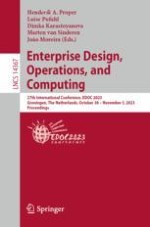2024 | Buch
Enterprise Design, Operations, and Computing
27th International Conference, EDOC 2023, Groningen, The Netherlands, October 30 – November 3, 2023, Proceedings
herausgegeben von: Henderik A. Proper, Luise Pufahl, Dimka Karastoyanova, Marten van Sinderen, João Moreira
Verlag: Springer Nature Switzerland
Buchreihe : Lecture Notes in Computer Science
